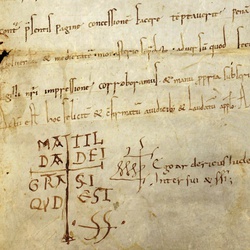Matilde di Canossa
Valle del Serchio. Più vicino a te

Matilde di Canossa was one of the most powerful women of medieval Italy. The daughter of Bonifacio III of Canossa and Beatrice di Lotaringia, she boasted imperial blood and direct family ties with dukes, emperors and popes. After a troubled childhood, marked by the premature death of her father and two brothers, she moved to Germany to the court of Emperor Henry III. She married Goffredo il Gobbo, the son of her mother's second husband, but in 1072, by then regarded as the bearer of catastrophe after the death of her daughter Beatrice, she returned to Canossa. On the death of her mother, Matilde was invested with authority over the house of Canossa and, from then on, governed the family's possessions.
Fortified by her political, economic and military power, she strenuously supported the Church of Rome in the investiture contest that set the papacy against the empire. The events are well-known that led Henry IV to be humbled at Canossa and the epilogue of the diatribe of 1092 with the overwhelming victory of the troops of the Countess who, fortified in the castles owned by Matilde, did not grant the emperor any opportunity to advance.
The presence of Matilde in the Valley is confirmed in deeds preserved in the castle of Fosciano, an ancient stronghold, since destroyed, located a little way from Pieve Fosciana, in the place called "castle". The personal rule of this powerful figure extended over two other strongholds, the castles of Diecimo and Colle di Pastino, so almost to the gates of the city of Lucca. It is a widely-held opinion that the Grand Countess loved these lands and is said to have funded the construction of many churches, including the parish church of Loppia, and that she was responsible for the building of the Ponte della Maddalena at Borgo a Mozzano, known as “Devil’s Bridge” because of its shape.
Often Matilde had to negotiate the mountain passes that led to Lucca and it is said that, during one of these trips, after going through the Passo di Pradarena, a violent storm of such force blew up that the unfortunate members of the group feared for their lives. When everything appeared lost, Matilde began to pray and implored the Lord to save her and her court. In exchange for this grace, she offered God a solemn offering that she would build a place of worship there. Suddenly the storm stopped and the Countess could continue her journey, but she did not forget her promise and constructed a little hospital dedicated to San Sisto in the town of Sillano.
In spite of her power and the wealth inherited and accumulated , the Grand Countess could do nothing against gout, the illness that brought her death on 24 July 1115, before her assets could be divided among her direct descendants. The immense wealth incited the greed of many, who tried at all costs to secure a part, but in the end the donation signed by the Countess bequeathing everything to the Holy See was authenticated and ratified.



